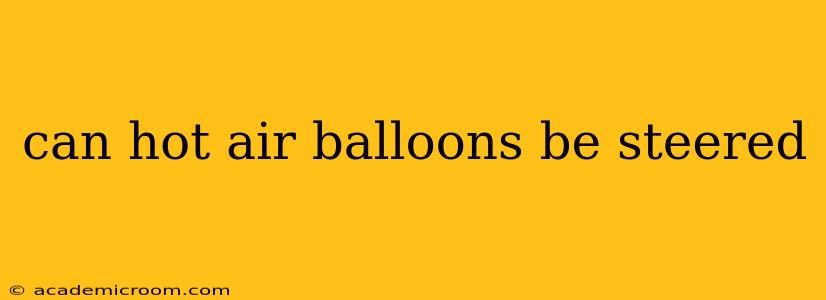Can Hot Air Balloons Be Steered? The Answer Is Surprisingly Complex
The short answer is: not directly, like a plane or a car. Hot air balloons lack the directional control mechanisms found in other aircraft. However, the statement that hot air balloons cannot be steered is also inaccurate. Let's delve deeper into the nuances of hot air balloon navigation.
How Do Hot Air Balloons Work?
Understanding how hot air balloons work is key to understanding their steering limitations. Hot air balloons rise and fall by manipulating the temperature of the air inside the envelope (the large balloon). Heating the air makes it less dense than the surrounding air, causing the balloon to rise. Cooling the air causes it to descend. This is the only direct control a pilot has.
So, How Do Pilots Navigate?
While pilots can't directly steer a hot air balloon left or right, they use a combination of techniques to influence their direction:
-
Wind currents: This is the primary means of navigation. Pilots carefully study weather patterns and wind forecasts before flight to determine the prevailing winds at different altitudes. They then use these winds to navigate to their desired destination. This requires a significant degree of planning and awareness of changing wind conditions.
-
Altitude adjustments: By adjusting the balloon's altitude, pilots can take advantage of different wind currents at various heights. Higher altitudes often have different wind speeds and directions than lower altitudes. This allows pilots to "steer" by selecting favorable wind currents.
-
Understanding wind patterns: Experienced pilots become adept at reading the landscape and identifying microclimates, which can indicate changes in wind direction and speed. This knowledge helps them to anticipate shifts and make subtle adjustments to altitude to optimize their trajectory.
Can Hot Air Balloons Be Steered Using a Propeller or Other Mechanisms?
Yes, there are airships that are similar to hot air balloons but are steerable. These are often referred to as "lighter-than-air" crafts. Airships employ propellers or other propulsion systems to provide directional control, in addition to the buoyancy control offered by heated air. However, these are distinct from the traditional hot air balloons we typically associate with the term.
What are the limitations of steering a hot air balloon?
The limitations are significant:
- Complete reliance on wind: The pilot has almost no control over the horizontal direction. The flight is entirely at the mercy of the prevailing winds.
- Inaccurate predictions: Wind forecasts can be inaccurate, particularly on a smaller scale. Sudden shifts in wind can disrupt planned routes.
- Safety concerns: Unforeseen changes in wind conditions can lead to safety concerns, particularly when landing.
What factors affect the steerability of a hot air balloon?
The size and shape of the balloon, the burner's efficiency, and the skill of the pilot all play a role in the ability to "steer" through the use of altitude adjustments and wind currents. However, the fundamental limitation remains: a lack of direct control over horizontal direction.
Are there any new technologies improving steering capabilities?
While significant breakthroughs in directly steering hot air balloons are unlikely, research into improved weather forecasting and real-time wind data could enhance navigation accuracy. Better prediction would give pilots more precise control over their flight path, even within the constraints of wind dependence.
In conclusion, while you can't steer a hot air balloon in the same way you steer a car, experienced pilots skillfully use available wind currents and altitude adjustments to navigate, achieving surprisingly accurate landings and covering considerable distances. The ability to steer is a matter of degree, not an all-or-nothing proposition.
